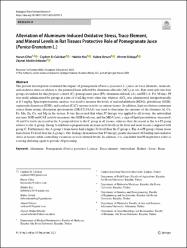Alleviation of Aluminum-Induced Oxidative Stress, Trace Element, and Mineral Levels in Rat Tissues Protective Role of Pomegranate Juice (Punica Granatum L.)

Göster/
Erişim
info:eu-repo/semantics/openAccessTarih
2023Yazar
Çiftçi, HarunÇalışkan, Çiğdem Er
Koç, Habibe
Öztürk, Kübra
Özkaya, Ahmet
Erbeşler, Zeynel Abidin
Üst veri
Tüm öğe kaydını gösterKünye
Ciftci, H., Caliskan, C. E., Koc, H., Ozturk, K., Ozkaya, A., & Erbesler, Z. A. (2023). Alleviation of Aluminum-Induced Oxidative Stress, Trace Element, and Mineral Levels in Rat Tissues Protective Role of Pomegranate Juice (Punica Granatum L.). Biological Trace Element Research, 1-12.Özet
The present investigation examined the impact of pomegranate (Punica granatum L.) juice on trace elements, minerals, and oxidative stress in relation to the potential harm inflicted by aluminum chloride (AlCl3) in rats. Rats were split into four groups at random for this purpose: control (C), pomegranate juice (PJ), aluminum chloride (A), and PJ + A. For 30 days, PJ was orally administered by gavage at a rate of 4 mL/kg every other day, whereas AlCl3 was administered intraperitoneally at 8.3 mg/kg. Spectrophotometric analysis was used to measure the levels of malondialdehyde (MDA), glutathione (GSH), superoxide dismutase (SOD), and catalase (CAT) enzyme activity in various tissues. In addition, high-resolution continuum source flame atomic absorption spectrometry (HR-CS FAAS) was used to determine the amounts of the elements Al, Cu, Fe, Mn, Zn, Ca, and Mg in the tissues. It was discovered that when PJ therapy was applied to all tissues, the antioxidant enzymes SOD and CAT activity increased, the GSH level rose, and the MDA level, a sign of lipid peroxidation, decreased. Al and Ca levels increased in the A group relative to the C group in all tissues, whereas they decreased in the A + PJ group relative to the A group. Group A exhibited a proportionate increase in Fe levels in the liver and renal tissues compared with group C. Furthermore, the A group’s brain tissue had a higher Fe level than the C group’s. The A + PJ group’s brain tissue had a lower Fe level than the A group’s. Our findings demonstrate that PJ therapy greatly decreased Al buildup and oxidative stress in tissues while controlling variations in trace element levels. In addition, it is concluded that PJ might have value as a strong chelating agent to prevent Al poisoning. © 2023, The Author(s), under exclusive licence to Springer Science+Business Media, LLC, part of Springer Nature.

















